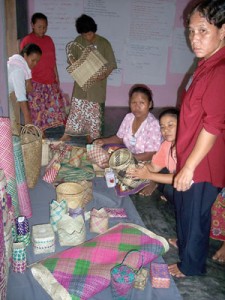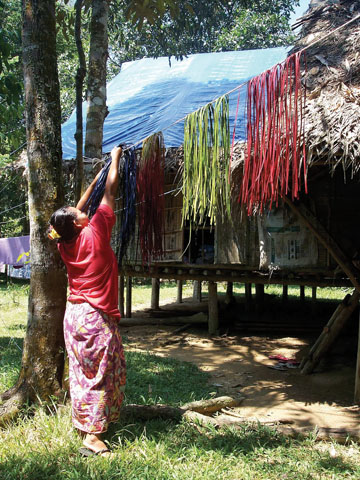by Reita Faida Rahim
The Orang Asli are the indigenous minorities of Peninsula Malaysia and have long been harvesting NTFPs either for their own use or for sale to middlemen. However Aslian crafts are uncommon in the market due to various factors including lack of natural resources, accessibility and marketability. Pandanus-based crafts are particularly vulnerable as many villages have lost their pandanus clumps due to development. Many Orang Asli women also no longer weave as plastic mats and baskets are more durable and easier to obtain; and as processing and weaving pandanus involve considerable effort.
In order to revive and revitalise their pandanus crafts, Gerai OA has actively encouraged Orang Asli women from several ethnic groups to weave as a supplementary source of income. We also provide access to the lucrative urban market in Kuala Lumpur via our mobile, volunteer-run stall.
While working with individual weavers in different villages was vital, there was also a need to bring the different weavers together as each had different skills and variations in weaving styles.
With encouragement and funding from NTFP-EP, Gerai OA organised a centralised three-day Pandanus Masterclass to strengthen both the production techniques and resolve of Orang Asli women who are determined to maintain and profit from their indigenous craft heritage.
Held in Kampung Chang Lama in Bidor, Perak, this was the first time most of the women had met each other even though all were part of Gerai OA’s network. Twenty-four weavers from six Orang Asli ethnic groups attended the workshop. We also welcomed Margiolina, a masterweaver from Negros, Philippines and two facilitators from NTFP-EP to add to the learning mix.

Many participants were masterweavers while the remaining were novices. All brought samples of their traditional and contemporary weavings to show, be reviewed then subsequently sold. The women soon settled into their new ‘village’ and were weaving at every opportunity – even during meal breaks and up to midnight.
There were no fixed teaching (or learning) methods so as to replicate communal knowledge sharing. The masterweavers who attended were the instructors, each specialising in different skills. They enjoyed sharing what they knew and were honoured to be ‘teachers.’ All weavers also managed to pick up new skills, notably in dyeing and production techniques.
The ‘teaching mat’ probably caused the most excitement as many were seen weaving copies of the motifs it contained. Weavers were also reminded to document their motif repertoire by weaving their own ‘teaching mat.’ Each village was also given a pandanus pattern book to learn from.
Basic lessons on marketing were introduced as was the importance of colours for different markets. Networking opportunities were also explored and also the importance of maintaining and replanting pandanus clumps.
Many problems were highlighted during a mind-mapping session and they were surprised to hear that weavers in different villages also faced similar problems, especially the lack of pandanus and disinterest in weaving among the young.
After three very productive days, these women returned to their villages armed not only with new production techniques but also a visible new resolve and confidence in their abilities. Some even went back carrying polybags of different pandanus seedlings which they obtained from fellow weavers.
Follow-up visits over the last two months have been very encouraging as many weavers have actively experimented with new colour schemes and dyeing techniques, while others have woven new or modified products. New products include pandanus earrings, pouches and lidded containers which have been well-received by urban buyers.
Some workshop participants have also actively encouraged others in their village to weave and this has resulted in several requests for village-level workshops, especially on dyeing and weaving techniques for novices. Others have begun replanting pandanus seedlings on pocket lands and are now very aware of sustainable uses of their forest resources.
CONTACT: Gerai OA c/o Reita Faida Rahim
1-3-3 Ixora Apartment, Lot 1106, PT6, Seksyen 62
Jalan Tun Razak, 50400 Kuala Lumpur, Malaysia
Tel: +6019 751 8686
Fax: +603 9221 1886
reitafaidarahim@yahoo.com.my




